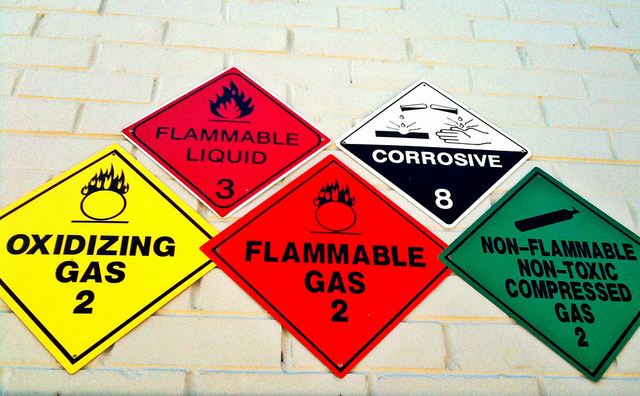With legislation action on climate change deadlocked by partisan divisions in Congress, the Obama Administration is pursuing a growing set of administrative and regulatory initiatives under existing authority. Many of these involve actions by the Environmental Protection Agency (EPA) applying Clean Air Act (CAA) authority, but some involve other EPA authority and/or other agencies.
Audit, Compliance and Risk Blog
Tags: Health & Safety, Environmental risks, Environmental, EPA, Hazcom
Environmental Compliance: EPA Revises Volatile Organic Compounds
Posted by STP Editorial Team on Wed, Jan 15, 2014
Effective November 21, 2013, EPA exempted 2,3,3,3-tetrafluoropropene (also known as HFO–1234yf) from the regulatory definition of Volatile Organic Compounds (VOCs). This compound will not be counted as a VOC for entities using or producing HFO–1234yf in a product other than an aerosol coating, limiting the VOC emissions from a facility, or otherwise controlling the use of VOC for purposes related to attaining the ozone NAAQS. Emissions of this compound will not be considered in determining whether a proposed new or modified source triggers the applicability of Prevention of Significant Deterioration (PSD) requirements, in areas where the PSD program is implemented by the EPA or a delegated state, local, or tribal agency. This action may also affect whether HFO–1234yf is considered a VOC for state regulatory purposes, depending on whether the state relies on the EPA’s regulatory definition of VOCs.
Tags: Health & Safety, Environmental risks, Environmental, EPA, Greenhouse Gas, ghg, Hazcom, Oil & Gas
In response to what it describes as “an alarming increase” in worksite injuries and fatalities related to communication tower activities, the federal Occupational Safety & Health Administration (OSHA) recently issued a memorandum for regional administrators. Intensified upgrades to cellular infrastructure (to cite an example from a few years ago, preparation to introduce 3G service) are likely contributing to the toll: 14 incidents in just a few months of 2013, a total greater than that of the previous two years combined.
Tags: Employer Best Practices, Health & Safety, OSHA, Employee Rights, California Legislation, Training
OSHA: Is It Time To Update The Process Safety Management Standard?
Posted by Jon Elliott on Thu, Jan 09, 2014
The Occupational Safety and Health Administration’s (OSHA’s) Standard for Process Safety Management of Highly Hazardous Chemicals (usually referred to as “PSM”) in 1992, requires extensive risk assessments and reduction efforts by facilities where a significant incident involving these chemicals might have catastrophic consequences. OSHA adopted PSM in 1992, and has made only minor technical revisions in the ensuing two decades. However, several federal and state initiatives are developing recommendations and may lead to significant changes in 2014.
Tags: Employer Best Practices, Health & Safety, OSHA, Training, Environmental, EHS, Hazcom
December 1, 2013 marked the first major compliance deadlines for most employers to comply with revisions to the Occupational Safety and Health Administration's (OSHA's) Hazard Communication Standard (HCS or Hazcom) adopted by OSHA effective May 25, 2012. Hazcom provides basic chemical information in millions of workplaces in the U.S. (Canadian readers will be familiar with analogous Workplace Hazardous Materials Information System (WHMIS) requirements).
Tags: Corporate Governance, Health & Safety, OSHA, Training, Hazcom
Common Violations at Dealerships, Service and Repair Facilities
Posted by STP Editorial Team on Mon, Dec 09, 2013
Based on a limited survey of the Certified Unified Program Agencies (CUPAs) of the California Environmental Protection Agency (Cal/EPA), the Department of Toxic Substances Control (DTSC) found the following top eight violations:
Tags: Corporate Governance, Health & Safety, Environmental risks, Environmental, EPA
Environmental Compliance: EPA Tracks Reductions in GHG Emissions
Posted by Viola Funk on Fri, Dec 06, 2013
Do you ever wonder whether auditing of greenhouse gas emissions is working? It may be a bit early in the game to say for sure, given that GHG emission tracking standards are a recent phenomenon. But an annual report compiled by the U.S. Environmental Protection Agency (EPA) may be a good gauge of trends in emission reductions, judging by its latest installment.
Tags: Corporate Governance, Business & Legal, Health & Safety, Environmental risks, Environmental, EHS, EPA, Greenhouse Gas, ghg
Move Over Hazardous Chemicals … Here Comes Something Safer!
Posted by STP Editorial Team on Wed, Dec 04, 2013
American workers suffer more than 190,000 illnesses and 50,000 deaths annually as a result of working with and being exposed to tens of thousands of chemicals every day. Workplace chemical exposures have been linked to cancers, and other lung, kidney, skin, heart, stomach, brain, nerve, and reproductive diseases. While many of these chemicals are suspected of being harmful, only a fraction of them are regulated in the workplace.
Tags: Business & Legal, Health & Safety, OSHA, Environmental risks, Environmental, Hazcom
OSHA Proposes Expansion of Occupational Injury & Illness Reporting
Posted by Jon Elliott on Mon, Dec 02, 2013
The Occupational Safety and Health Administration (OSHA) requires employers to prepare and maintain records of occupational injuries and illnesses (I&Is), and to provide employees with annual summaries of I&I statistics for their "establishment." At present, OSHA and/or the Department of Labor's Bureau of Labor Statistics (BLS) can demand that selected employers report this information to them. BLS uses this information for statistical analyses of factors that cause workplace injuries and illnesses, and OSHA uses it to set rulemaking and enforcement priorities. In addition, OSHA requires all employers to report work-related accidents that result in one or more serious injuries or deaths (what OSHA calls "catastrophes").
Tags: Corporate Governance, Business & Legal, Employer Best Practices, Health & Safety, Employee Rights, Environmental
Canadian Clean-Up Order Must be Decided by Environmental Appeal Tribunal, Not Court
Posted by STP Editorial Team on Fri, Nov 22, 2013
Tags: Corporate Governance, Business & Legal, Health & Safety, Environmental risks, Environmental, Hazcom, Canadian










